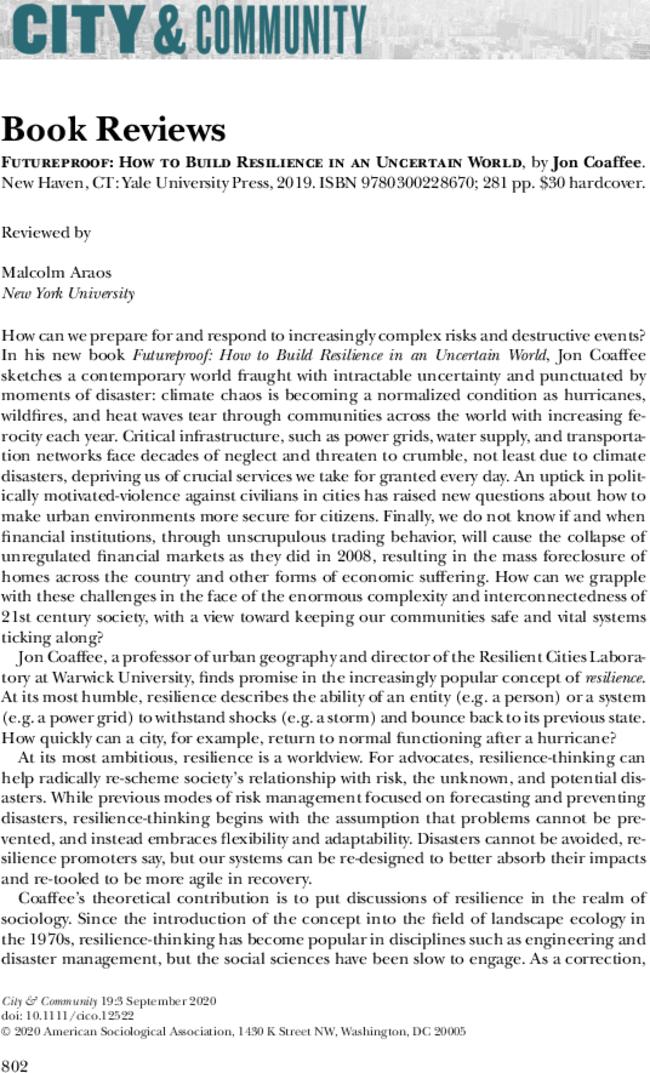Futureproof: How to Build Resilience in an Uncertain World, by Jon Coaffee. New Haven, CT: Yale University Press, 2019. ISBN 9780300228670; 281 pp. $30 hardcover.
IF 3
3区 社会学
Q1 SOCIOLOGY
引用次数: 3
Abstract
How can we prepare for and respond to increasingly complex risks and destructive events? In his new book Futureproof: How to Build Resilience in an Uncertain World, Jon Coaffee sketches a contemporary world fraught with intractable uncertainty and punctuated by moments of disaster: climate chaos is becoming a normalized condition as hurricanes, wildfires, and heat waves tear through communities across the world with increasing ferocity each year. Critical infrastructure, such as power grids, water supply, and transportation networks face decades of neglect and threaten to crumble, not least due to climate disasters, depriving us of crucial services we take for granted every day. An uptick in politically motivated-violence against civilians in cities has raised new questions about how to make urban environments more secure for citizens. Finally, we do not know if and when financial institutions, through unscrupulous trading behavior, will cause the collapse of unregulated financial markets as they did in 2008, resulting in the mass foreclosure of homes across the country and other forms of economic suffering. How can we grapple with these challenges in the face of the enormous complexity and interconnectedness of 21st century society, with a view toward keeping our communities safe and vital systems ticking along? Jon Coaffee, a professor of urban geography and director of the Resilient Cities Laboratory at Warwick University, finds promise in the increasingly popular concept of resilience. At its most humble, resilience describes the ability of an entity (e.g. a person) or a system (e.g. a power grid) to withstand shocks (e.g. a storm) and bounce back to its previous state. How quickly can a city, for example, return to normal functioning after a hurricane? At its most ambitious, resilience is a worldview. For advocates, resilience-thinking can help radically re-scheme society’s relationship with risk, the unknown, and potential disasters. While previous modes of risk management focused on forecasting and preventing disasters, resilience-thinking begins with the assumption that problems cannot be prevented, and instead embraces flexibility and adaptability. Disasters cannot be avoided, resilience promoters say, but our systems can be re-designed to better absorb their impacts and re-tooled to be more agile in recovery. Coaffee’s theoretical contribution is to put discussions of resilience in the realm of sociology. Since the introduction of the concept into the field of landscape ecology in the 1970s, resilience-thinking has become popular in disciplines such as engineering and disaster management, but the social sciences have been slow to engage. As a correction,

《未来证明:如何在一个不确定的世界中建立弹性》,作者:Jon coffee。康涅狄格州纽黑文:耶鲁大学出版社,2019年。ISBN 9780300228670;281页,精装本30美元。
本文章由计算机程序翻译,如有差异,请以英文原文为准。
求助全文
约1分钟内获得全文
求助全文

 求助内容:
求助内容: 应助结果提醒方式:
应助结果提醒方式:


